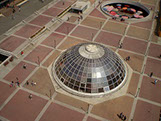







Invited Speakers
Adrian Stoica
Senior Research Scientist NASA Jet Propulsion Laboratory Pasadena, USA
PRESENTATION: A Solar Power Infrastructure at the Moon’ South Pole
Adrian Stoica was born in Iași, Romania. He obtained his Diploma of Engineering in Electrical Engineering from Technical University of Iași in 1986 and his PhD from Victoria University of Technology in Melbourne, Australia in 1996. Since 1996 he has been with the NASA Jet Propulsion Laboratory (JPL), California Institute of Technology in Pasadena, California. JPL is the leading NASA Center for robotic space exploration. Between 2008 and 2018 he managed the Robotic Systems Estimation and Controls Group. He is now Program Executive for Blue Sky Studies Program, and Coordinator of the Innovation to Flight Program at JPL. He is a NIAC Fellow (NASA Innovative Advanced Concepts) having led a study on a solar power infrastructure at the lunar South Pole. His research interests include robotic intelligence and learning, collaboration between humans and teams of robots, non-conventional computing, and technologies for enhanced quality of life. He is Vice-President for Membership and Student Activities in the IEEE Systems, Man, and Cybernetics Society. He was General Chair of the 38th Annual Congress of the American Romanian Academy of Arts and Sciences (ARA) in Pasadena, California, July 23-27, 2014.
Abstract of the talk:
A Solar Power Infrastructure at the Moon’ South Pole
Adrian Stoica
Senior Research Scientist
NASA Jet Propulsion Laboratory Pasadena, CA 91107, USA
Abstract: The Moon is becoming again a primary target of near term space missions. Various concepts, such as the Moon Village promoted by the European Space Agency (ESA), offer a vision of collaboration via assets (infrastructure and robotic systems) owned (and operated) independently, by different nations, yet engaged in mutual support and assistance, in a robotic ecosystem. Private companies are now joining the space race and their presence on the surface of the Moon is imminent. The space economy is expanding from low Earth-orbit to cis-lunar space and then to lunar surface. The Moon is seen as a spaceport which offers the advantage of a lower gravity and may even provide the propellant for Mars and beyond, in the form of hydrogen and oxygen mined from its icy regolith, the largest concentration of such resources being at the lunar poles, in permanently shaded regions (PSR). Regions close to the poles, for example at around Shackleton crater at the South Pole also have an abundance of sunlight, some points in the region being illuminated over 85% of the time during the year. This paper presents aspects of designing, building, and operating a solar power infrastructure around Shackleton crater, and its implications for facilitating a lunar economy. It addresses the design needed to obtain power continuously, uninterrupted, 100% of the time during the year. Power. It addresses the trade-offs in the placement of solar reflectors, the height of towers on which to place the reflectors and the size of reflective surfaces; how to place the reflectors and how to maintain and operate. These factors influence which regions can become “oasis of energy“ in which robots and robotic infrastructure, such as in-situ resource utilization (ISRU) equipment could operate while being warmed and powered by reflected/redirected solar energy. To ensure continuous power even during 2 to 4 hours solar eclipses, when Earth blocks the view of the Sun, short term energy storage is also considered in the form of a modified Magaldi system operating with lunar dust instead of sand as used in Earth. For transmission to longer distances, the energy is converted to electricity and transmitted by laser or microwaves. A network on a radius of tens of kilometers around the South Pole (situated on the rim of Shackleton crater) would include many PSR and regions where mining, lunar bases, and scientific missions can be carried out while not having to deal with darkness and temperatures as low as 70K. The infrastructure would change the way of operating lunar missions, lowering barriers of entry as one would no longer need to qualify for extreme temperatures, or operate only in 14 (terrestrial) days missions. This would dramatically lower the costs of operations on the Moon and would be a keystone in the rise of a lunar economy.
Keywords: Magdali system, Moon, lunar economy, robotic space exploration, solar power, space missions





